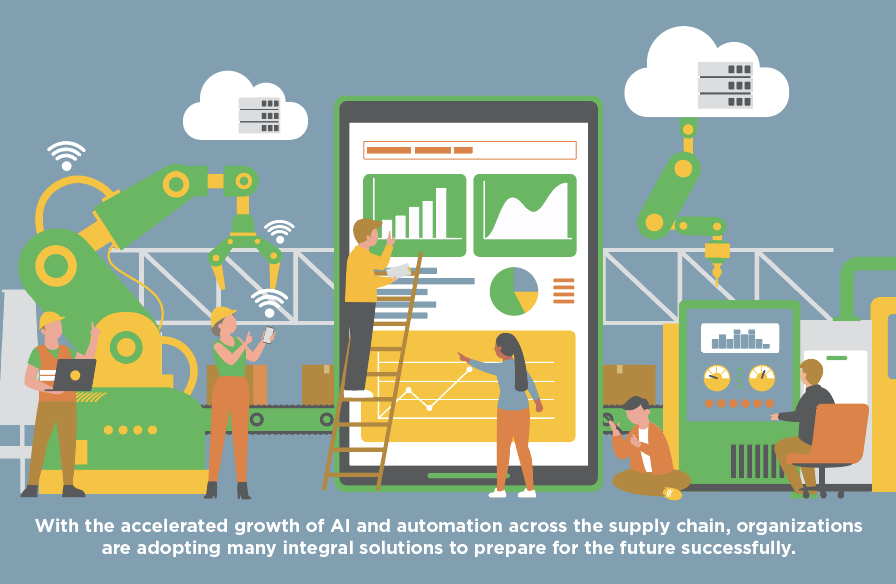The past decade has seen an explosive adoption of artificial intelligence (AI) and automation in supply chains. This rise in new technologies has been a valuable opportunity for businesses to boost efficiency, increase customer satisfaction, and minimize costs. Read on to discover how your team can bring about a new era of efficiency and resilience by adopting these tools.
The growth of cutting-edge technology in the supply chain
Companies with supply chains at their core are quickly employing state-of-the-art technologies to support long-term business growth. The need for enhanced operational efficiency and cost reduction, the rising complexities and interconnected nature of supply chains, the exponential growth of data and analytics, and increasing customer expectations for faster deliveries, personalization, and transparency have triggered this accelerated adoption. Because the integration of technologies has emerged as a powerful catalyst for achieving success amid a rapidly changing landscape, we are taking a closer look at the principal systems utilized by supply chain organizations today.

5 Key AI and automation technologies driving supply chain transformations
Considering the ever-evolving supply chain environment, it is no surprise that teams are turning to robust AI and automation technologies to enhance efficiency and establish a competitive advantage. Here are six solutions organizations are implementing to transform their operations:
The metaverse
The metaverse — a virtual reality space — has opened the doors to unique opportunities for supply chain teams to reconcile supply and demand. Within this environment, businesses can create virtual simulations and utilize real-time monitoring that provides greater visibility into processes, facilities, inventory, and capacity.
According to the Accenture Technology Vision 2022 report, 71% of supply chain management executives believe the metaverse will positively impact organizations. These benefits include:
- Improving visibility at all stages of production and distribution.
- Boosting demand planning and problem-solving.
- Increasing connectivity and chances for collaboration.
- Empowering sustainability efforts.
Predictive analytics
Solutions that equip your company with robust analytics provide the capability to analyze historical data and up-to-date information. These tools will be a cornerstone in accurately forecasting demand, anticipating market trends, and optimizing inventory levels.
Warehouse operations teams have embraced analytics to anticipate demand fluctuations and ensure timely order fulfillment. While professionals in logistics, on the other hand, take advantage of real-time data to optimize route planning, predict transportation capacity needs, and proactively manage disruptions.
Internet of Things (IoT) and sensors
IoT devices and sensors are revolutionizing the supply chain as we know it by connecting physical assets and products to the Internet. As a result, supply chain organizations have access to real-time insights and greater oversight. In addition, using AI in conjunction with IoT applications is a powerful approach to keep your business consistently up-to-date and safeguarded against risk.
In the modern supply chain, teams are leveraging IoT systems and sensors to:
- Track the location and condition of goods during transportation.
- Monitor warehouse environmental factors (e.g., temperature and humidity).
- Optimize equipment maintenance schedules.
Robotic process automation (RPA)
Now considered a game changer in the supply chain, robotic process automation (RPA) has become an increasingly popular strategy for automating repetitive, manual tasks. These tasks include order processing, data entry, inventory management, and shipment tracking, to name a few. RPA tech is here to stay, with Grand View Research projecting the global RPA market — valued at $2,322.9 million in 2022 — to expand at a compound annual growth rate of 39.9% until 2030.
Machine learning
Today, AI applications are adopted to analyze massive amounts of data and uncover valuable insights. The patterns and trends discovered can help organizations streamline routing, identify anomalies, and improve decision-making.
It is important to remember that AI and automation technologies are not one-size-fits-all. It will be necessary to assess different potential systems and how they might fit into your unique strategy and technology stack for the best results.
What are the benefits of integrating new technologies?
Transformative technologies that enable unique business objectives provide supply chain organizations with a myriad of advantages, such as:
- Boosting supply chain management: Cutting-edge technology equips teams with the real-time visibility and tracking capabilities needed to achieve comprehensive operational oversight. This technology enables proactive monitoring and bottleneck management.
- Improving customer experience: Solutions that support accurate demand forecasting, more efficient order processing, and timely delivery help minimize the impact of disruptions and increase long-term customer satisfaction.
- Removing barriers between different business functions: Introducing AI and automation breaks down silos and promotes cross-functional collaboration, leading to better coordination and faster decision-making in a more efficient value chain.
- Optimizing and streamlining operations: Automation is an efficient tool for eliminating repetitive tasks and promoting efficiency while minimizing human error. With AI, teams can enhance demand forecasting and inventory management to improve operational performance.
- Driving cost-efficiency: Supportive technologies pinpoint where there is room to save costs and improve resource use — maximizing long-term profitability.
Adopting AI and automation solutions successfully
While the supply chain continues to grow more complex, market analysis from Research and Markets reveals that AI-enabled supply chains are 67% more effective than non-AI-enabled supply chains. This descrepancy is due to mitigated risks and lower overall expenses. To introduce new tech successfully, be sure to:
- Establish a focused AI and automation strategy where you have outlined specific goals, priorities, and desired outcomes.
- Create an environment that embraces innovation by encouraging collaboration, communication, and upskilling among team members.
- Start with smaller pilot projects, learn from the process, and gradually scale your use of technologies.
Oracle Cloud solutions can help your organization prepare for the future by creating metaverse-ready enterprise resource planning (ERP) systems. By bringing together the right teams and technology, Oracle and Inspirage can empower your business to optimize its use of AI and automation technologies.
Contact us today to learn more about our customized solutions and world-class Oracle Cloud expertise.